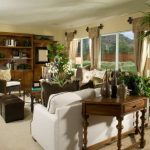What is a good home decor budget? Decorating your home is an exciting process that allows you to express your unique style and create a space that reflects your personality. However, without a well-planned budget, it’s easy to overspend and end up with financial stress. Having a set budget for home decor is crucial to ensuring that you achieve the look you want without breaking the bank.
Setting a budget for home decor involves calculating your total income and expenses to determine how much you can allocate towards decorating your space. This foundational step will help you understand what resources are available for purchasing new items, hiring professionals, or tackling DIY projects within your means. Whether you opt for a fixed budget or a flexible one will depend on your financial situation and personal preferences.
As you start planning your home decor budget, it’s essential to prioritize spending on key items that will have the most significant impact on the overall look and feel of your space. Allocating funds wisely towards furniture, lighting, art pieces, and other essential decor elements will ensure that you create a cohesive and stylish environment without overspending.
Additionally, considering DIY options versus professional services can help you make informed decisions based on cost-effectiveness and desired outcomes within your predetermined budget constraints.
Setting the Foundation
Setting a solid foundation for your home decor budget is essential to ensure that you can achieve the design style you desire without overspending. The first step in this process is calculating your total budget based on your income and expenses.
Start by determining how much disposable income you have available each month after covering essential expenses such as rent or mortgage, utilities, groceries, and savings. This will give you a clear picture of how much you can comfortably allocate towards home decor without sacrificing other financial obligations.
Once you have a clear understanding of your monthly disposable income, it’s important to consider setting aside a specific percentage or fixed amount for home decor expenses. Some experts recommend allocating around 10-15% of your monthly budget towards decorating your home, but this can vary depending on individual financial circumstances and priorities.
By creating a designated budget for home decor, you can avoid impulse purchases and make more intentional decisions about where to invest your money to enhance the aesthetic appeal of your living space.
When determining what is a good home decor budget for your unique situation, it’s important to strike a balance between affordability and quality. Remember that cost doesn’t always equate to value, so prioritize investing in pieces that will stand the test of time both in terms of durability and style.
By carefully assessing your income, expenses, and financial goals, you can establish a realistic budget that allows you to create a beautiful and functional home environment that reflects your personal taste and lifestyle preferences.
Different Budgeting Approaches
When it comes to home decor, one of the most crucial aspects to consider is setting a budget. But what exactly constitutes a good home decor budget? A common dilemma that homeowners face is deciding between a fixed budget or a flexible budget for their decor projects. Each approach has its own set of pros and cons, and understanding which one suits your needs best is essential for successful decorating.
Fixed Budget:
- With a fixed budget, you set a specific amount that you are willing to spend on your home decor projects.
- This approach provides a clear outline of your financial boundaries, preventing overspending and ensuring that you stay within your means.
- However, a fixed budget may limit your flexibility in making spontaneous purchases or accommodating unexpected expenses that may arise during the decorating process.
Flexible Budget:
- A flexible budget allows for more freedom in adjusting your spending based on changing circumstances or opportunities that may present themselves.
- It enables you to take advantage of sales or discounts without feeling restricted by predefined spending limits.
- On the downside, without strict parameters in place, there is a risk of going overboard with spending and losing track of your overall budget.
Deciding between a fixed budget and a flexible budget ultimately comes down to personal preference and financial stability. Some homeowners may prefer the discipline imposed by a fixed budget, while others might appreciate the adaptability offered by a flexible approach.
Whichever option you choose, the key is to stick to your allocated funds while allowing for some degree of flexibility to accommodate unexpected expenses or opportunities as they arise. Flexibility can be beneficial as long as it is managed responsibly within the confines of your overall home decor budget.
How to Prioritize Spending
Identifying Key Decor Items
When it comes to decorating your home within a budget, it is essential to identify key decor items that will have the most impact on your space. These key items typically include furniture pieces, such as sofas, dining tables, and beds, as well as focal point decor elements like artwork or statement lighting fixtures. By focusing on investing in these key items first, you can create a solid foundation for your decor that can be built upon over time.
Allocate Funds Wisely
Once you have identified the key decor items for your space, it is important to allocate your budget wisely. Consider allocating a larger portion of your budget to high-quality furniture pieces that will last for years to come, while setting aside a smaller budget for trendier decor accessories that can easily be swapped out as styles change. Remember that investing in quality pieces upfront may save you money in the long run by reducing the need for frequent replacements.
Budget-Friendly Alternatives
If you find that your budget constraints make it challenging to invest in all the key decor items you desire, consider exploring budget-friendly alternatives. Thrift stores, online marketplaces, and discount retailers can be excellent sources for affordable yet stylish home decor items.
Additionally, consider DIY projects or upcycling existing pieces to create custom decor without breaking the bank. By getting creative and thinking outside the box, you can achieve a beautifully decorated home while staying within your desired budget range.
DIY vs Professional Services
When it comes to home decor, deciding between DIY projects and hiring professional services can have a significant impact on your overall budget. Each option has its own set of pros and cons that should be carefully considered before making a decision. Here are some factors to keep in mind when determining the best approach for your home decor needs:
- Cost: One of the main considerations when weighing DIY versus professional services is cost. DIY projects can often be more budget-friendly since you are not paying for labor or markup on materials. However, professional services may offer discounts on bulk materials and have access to higher quality products.
- Time and Skill Level: Another important factor to consider is the time and skill level required for the project. DIY projects can be time-consuming, especially if you lack experience or expertise in a particular area. On the other hand, hiring professionals can save you time and ensure a higher quality finish.
- Personalization and Customization: DIY projects allow for greater personalization and customization, as you have full control over the design process. However, professional services often come with a team of experts who can provide guidance and suggestions for creating a cohesive look within your budget.
Ultimately, the decision to choose between DIY or professional services for your home decor projects will depend on your budget, timeline, skill level, and personal preferences. By weighing the pros and cons of each option, you can make an informed decision that aligns with your goals for creating a beautiful living space within your means. It’s essential to strike a balance between cost-effectiveness and achieving the aesthetic vision you desire.
Hidden Costs to Consider
When planning a home decor budget, it is essential to consider not only the cost of the items you want to purchase but also the hidden costs that may arise during and after the decorating process. Maintenance, repairs, and unexpected expenses can quickly add up if not accounted for in your budget. Here are some key aspects to keep in mind when planning for these hidden costs.
Regular Maintenance
One aspect of home decor budgets that is often overlooked is the need for regular maintenance of decor items and furnishings. Whether it’s cleaning supplies for upholstery or polishing materials for furniture, these routine maintenance tasks can add up over time. Setting aside a portion of your budget for these recurring expenses can help you keep your home looking its best without breaking the bank.
Repairs
Another important consideration when budgeting for home decor is the cost of potential repairs. No matter how careful you are with your belongings, wear and tear are inevitable. From fixing a broken frame to repairing a leaky faucet, having a fund designated for unexpected repairs can save you from financial stress down the line. By including an allowance for repairs in your budget, you can ensure that you’re prepared for any unforeseen issues that may arise.
Unexpected Expenses
Lastly, it’s crucial to account for unexpected expenses when creating a home decor budget. Whether it’s a sudden plumbing issue or a spontaneous redesign urge, having some flexibility in your budget can provide peace of mind in navigating unforeseen circumstances.
Consider setting aside a reserve fund specifically for unexpected expenses to avoid derailing your overall decor plans due to unexpected costs. By planning ahead and incorporating these hidden costs into your budget, you can create a more realistic and comprehensive financial plan for your home decor projects.
Shopping Smart
When it comes to decorating your home on a budget, there are several strategies you can utilize to find affordable decor items without compromising quality. One key tip is to shop at discount stores, thrift shops, and online marketplaces where you can find unique pieces at a fraction of the cost of brand-new items. Additionally, keeping an eye out for sales, clearance events, and seasonal promotions can help you score great deals on home decor.
Another way to save money on home decor is by DIY-ing certain pieces instead of purchasing them. By getting creative and repurposing items or making your own decor accents, you not only save money but also add a personal touch to your space. DIY projects can range from simple crafts like painting mason jars or creating wall art to more complex furniture makeovers or upholstery projects.
It’s also important to prioritize your spending when decorating on a budget. Allocate the majority of your funds towards key pieces that will have the biggest impact on the overall look of your home, such as a comfortable sofa, a durable dining table, or statement lighting fixtures. By investing in quality staples, you can then mix in more budget-friendly accessories and accents to complete the look without breaking the bank.
| Key Tip | Details |
|---|---|
| Shop at discount stores | You can find unique pieces at lower costs |
| DIY projects | Add a personal touch and save money by making your own decor accents |
| Allocate funds wisely | Invest in key pieces for impact and mix in more budget-friendly accessories. |
Revisiting Your Budget
After setting up an initial budget for your home decor projects, it’s essential to understand the importance of revisiting and adjusting your budget regularly. Life circumstances, financial situations, and decor trends can change, necessitating a review of your budget to ensure that it aligns with your current needs and priorities. By periodically revisiting your budget, you can stay on track with your financial goals while still creating a beautiful and comfortable living space.
One key aspect of revisiting your budget is to assess whether there have been any changes in your income or expenses that may impact the amount you can allocate towards home decor. If you’ve experienced a salary increase, for example, you may have more flexibility in expanding your decor budget.
Conversely, if unexpected expenses have arisen, you may need to scale back on certain aspects of your decor plans. Understanding these changes allows you to make informed decisions about where to allocate your funds effectively.
Additionally, as you progress with your home decor projects, you may discover new priorities or find that certain items are no longer as important to you. This is why regularly reviewing and adjusting your budget is crucial in ensuring that you’re investing in items that truly enhance your living environment.
By staying flexible and open to modifying your budget based on evolving needs and preferences, you can create a home that not only reflects your style but also remains within a reasonable financial range.
Conclusion
In conclusion, understanding what is a good home decor budget is crucial for ensuring successful and stress-free decorating projects. By setting a clear budget based on your income and expenses, you can avoid overspending and financial strain. Whether you opt for a fixed budget or a more flexible approach, prioritizing spending on key decor items will help you create a cohesive and aesthetically pleasing space without breaking the bank.
It’s essential to weigh the pros and cons of DIY projects versus professional services within your budget. While DIY can be cost-effective, some tasks may require expertise beyond your skill level. Additionally, considering hidden costs like maintenance, repairs, and unexpected expenses will help you better prepare financially for any unforeseen circumstances that may arise during or after the decorating process.
Remember to shop smart by exploring affordable options without compromising quality. Periodically revisiting and adjusting your budget as needed to accommodate changing needs and priorities is also crucial for the long-term success of your home decor projects. By staying organized, sticking to your budget, and making informed decisions, you can transform your living space into a place that reflects your style while staying financially responsible.
Frequently Asked Questions
What Is a Reasonable Interior Design Budget?
Establishing a reasonable interior design budget depends on various factors such as the scope of the project, size of the space, desired quality of materials, and specific design goals. Generally, allocating 10-15% of the total home value to interior design is a common guideline.
What Is a Good Budget for a Living Room?
Setting a good budget for a living room redesign involves considering the specific design elements you want to incorporate such as furniture, lighting, decor, and any necessary renovations. A typical range could be anywhere from $1,500 to $5,000 or more depending on your preferences.
What Is the 70 30 Rule in Interior Design?
The 70 30 rule in interior design suggests dividing your budget where 70% is allocated to foundational or larger items like furniture, flooring, and major fixtures while the remaining 30% is dedicated to accessories and smaller decorative pieces. This rule helps create balance and cohesion in your overall design scheme.

I’m thrilled to be your companion on this exciting journey through the world of home decor and design. With a passion for turning houses into homes and a keen eye for the finer details, I’m here to help you transform your living spaces into beautiful, functional, and meaningful havens.





